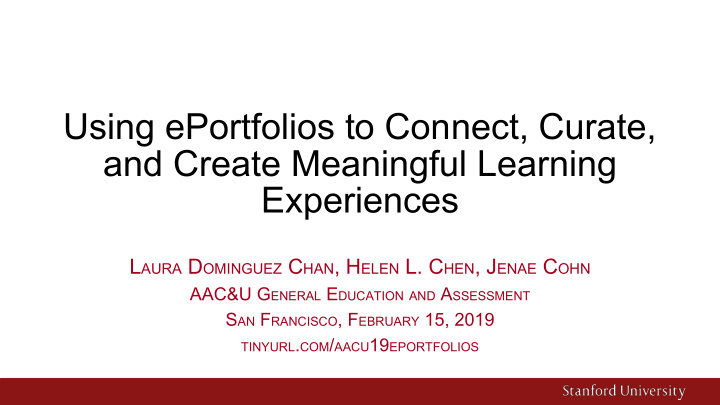



Using ePortfolios to Connect, Curate, and Create Meaningful Learning Experiences L AURA D OMINGUEZ C HAN , H ELEN L. C HEN , J ENAE C OHN AAC&U G ENERAL E DUCATION AND A SSESSMENT S AN F RANCISCO , F EBRUARY 15, 2019 TINYURL . COM / AACU 19 EPORTFOLIOS
What does 21st century learning look like?
Audrey Watters, Chris Gilliard, “Hack Education” “Shaming and Framing” Michael Caulfield
High-Impact Practices (Kuh, AAC&U 2008; AAC&U 2016) First-Year Experiences ● Common Intellectual Experiences ● Learning Communities ● Writing-Intensive Courses ● Collaborative Assignments and Projects ● Undergraduate Research ● Diversity/Global Learning ● ePortfolios ● Service Learning, Community-Based Learning ● Internships ● Capstone Courses and Projects ●
Bridging Academic Rigor with Practical Application to Empower Students/Faculty
Bridging Academic Rigor with Practical Application to Empower Students/Faculty
Agenda 1. Explore How ePortfolios in 21st Century Learning Contexts Reflect AAC&U’s Essential Learning Outcomes 2. Describe Our ePortfolio Class and its Activities 3. Connect ePortfolios to Learning Transfer in Career Contexts 4. Experience Activities to Scaffold ePortfolio Creation
Learning Outcomes of an ePortfolio ● Content curation ● Metacognition ● Audience awareness ● Self-advocacy ● Creativity ● Ability to compose in multiple media and genres ● Synthesis ● Analysis
Our Class: PWR 91OID ● Offered through the Program in Writing and Rhetoric ● Fulfills “Creative Expression” general education requirement ● All undergraduates can enroll ● Partnership with PWR (Jenae), Engineering Education (Helen), BEAM: Career Education (Laura), and Graduate School of Business (Sheetal)
Building Your Story Story What’s Your Purpose & Evidence & Build > > > > Building Story Now? Audience Architecture ePortfolio Blocks ● Experiences Build Digital ● Values Presence ● Skills ● Themes ● Story Strategies
Values “Relating narratives about defining moments and significant experiences are ways to understand an individuals’ needs, values and interests.” --Pope, Flores, Rottinghaus (2014) The Role of Values in Careers
Meaningful Work Kit Activity
Building Your Story In this course, defining moments and significant experiences are described as: Closely tied to your academic and professional ● interests Experiences you view as meaningful and where you ● utilized a skill(s) Opportunities where you were deeply engaged in ● what you were doing Activities you consider a highlight of your Stanford ● career
Building Blocks to Your Story
Community- Global Undergraduate Internships Based Learning Learning Research
Themes from Experiences Ethical Reasoning ● ○ integrity ○ excellence ○ trust Intercultural Understanding ● ○ empathy ○ global mindset ○ relationships Lifelong Learning ● ○ Intellectual challenge ○ passion ○ impact
Experience Reflection Session Write down the following: ■ Describe an experience (teaching experience/class assignment) OR personal project/experience ■ What skills/values do you hope are gained from your class project OR what skills/values did you gain from your personal experience? ■ What is the evidence that signifies this experience/project? Share your experience with your group: ■ Quickly comment on any themes. ■ What other thoughts come to mind as you hear that person share?
The Why ● What skills do you hope students gain from your course/activity/assignment? What artifacts could a student use? ● What skills did you gain from your personal experience, i.e., publication, conference, recent new responsibility/activity? What artifact(s)/evidence can you use?
Curating Your Narrative for an ePortfolio 1. Get into the same groupings as your experiences reflection. 2. Each group is going to receive two things: a stack of small slips of paper and a stack of Post-It Notes. 3. On the slips of paper, descriptions of real artifacts from past student ePortfolios will be listed. It is your group’s responsibility to look at the artifacts and decide under what themes or categories they should be organized. In other words, you and your group members will create a site map of an ePortfolio based on the artifacts you’ve been given. Use the Post-It notes to generate the categories or themes under which the artifacts can be grouped. 4. Be prepared to share how you all decided to organize the artifacts you were given!
Curating Your Narrative for an ePortfolio
The Why ● What story does the configuration of your artifacts communicate? ● How might your story change with a different configuration? Would different artifacts change that story or that configuration too? ● Were there other possible artifacts/evidence that you would consider adding?
Resources https://tinyurl.com/aacu19eportfolios
Q&A
Thank you! Laura Dominguez Chan, ldchan@stanford.edu @ldchan Helen L. Chen, hlchen@stanford.edu @helenlchen Jenae Cohn, jdcohn@stanford.edu @Jenae_Cohn
Panel of Career Educators
Providing input on content
Including Expertise
Including Recruiters/Organization Reps
Example ePortfolios
Recommend
More recommend